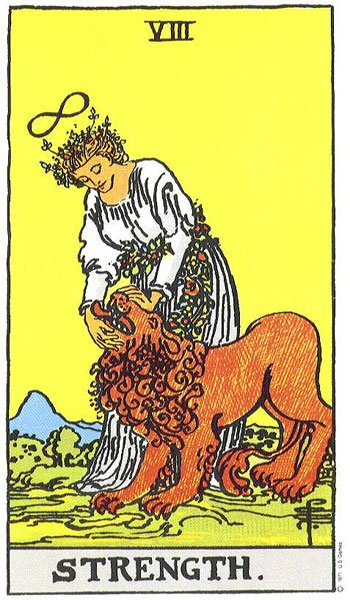LUST : KEY VIII (Strength)
Sol Rules
Uranus Exalted
Hebrew Letter: Teth (Serpent)
all things.
Worship the name _______,
foursquare, mystic, wonderful, and the name of
His House 418.
Alesiter Crowley
The Book of Thoth
This Trump was formerly called Strength. But it implies far more than strength in the ordinary sense of the word. Technical analysis shows that the Path corresponding to the card is not the Strength of Geburah, but the influence from Chesed upon Geburah, the Path balanced both vertically and horizontally on the Tree of Life (see diagram). For this reason it has been thought better to change the traditional title. Lust implies not only strength, but the joy of strength exercised. It is vigour, and the rapture of vigour.
The Lion-Serpent begets Gods! Thy throne The rampant Beast, our Lady Babalon!
This Trump is assigned to the sign of Leo in the Zodiac. It is the Kerub of Fire, and is ruled by the Sun. It is the most powerful of the twelve Zodiacal cards,’ and represents the most critical of all the operations of magick and of alchemy. It represents the act of the original marriage as it occurs in nature, as opposed to the more artificial form portrayed in Atu VI (The Lovers); there is in this card no attempt to direct the course of the operation.
The main subject of the card refers to the most ancient collection of legends or fables. It is necessary here to go a little into the magical doctrine of the succession of the Aeons, which is connected with the procession of the Zodiac. Thus, the last Aeon, that of Osiris, is referred to Aries and Libra, as the previous Aeon, that of Isis, was especially connected with the signs of Pisces and Virgo, while the present, that of Horus, is linked with Aquarius and Leo. The central mystery in that past Aeon was that of Incarnation; all the legends of god-men were founded upon some symbolic story of that kind. The essential of all such stories was to deny human fatherhood to the hero or god-man. In most cases, the father is stated to be a god in some animal form, the animal being chosen in accordance with the qualities that the authors of the cult wished to see reproduced in the child.
Thus, Romulus and Remus were twins begotten upon a virgin by the god Mars, and they were suckled by a wolf. On this the whole magical formula of the city Rome was founded.
Reference has already been made in this essay to the legends of Hermes and Dionysus.
The father of Gautama Buddha was said to be an elephant with six tusks, appearing to his mother in a dream.
There is also the legend of the Holy Ghost in the form of a dove, impregnating the Virgin Mary. There is here a reference to the dove of Noah’s Ark, bringing glad tidings of the salvation of the world from the waters. (The dwellers in the Ark are the foetus, the waters the amniotic fluid.)
Similar fables are to be found in every religion of the Aeon of Osiris: it is the typical formula of the Dying God.
In this card, therefore, appears the legend of the woman and the lion, or rather lion-serpent. (This card is attributed to the letter Teth, which means a serpent.)
The seers in the early days of the Aeon of Osiris foresaw the Manifestation of this coming Aeon in which we now live, and they regarded it with intense horror and fear, not understanding the precession of the Aeons, and regarding every change as catastrophe. This is the real interpretation of, and the reason for, the diatribes against the Beast and the Scarlet Woman in the XIII, XVII and XVIII-th chapters of the Apocalypse; but on the Tree of Life, the path of Gimel, the Moon, descending from the highest, cuts the path of Teth, Leo, the house of the Sun, so that the Woman in the card may be regarded as a form of the Moon, very fully illuminated by the Sun, and intimately united with him in such wise as to produce, incarnate in human form, the representative or representatives of the Lord of the Aeon.
She rides astride the Beast; in her left hand she holds the reins, representing the passion which unites them. In her right she holds aloft the cup, the Holy Grail aflame with love and death. In this cup are mingled the elements of the sacrament of the Aeon.
The Book of Lies devotes one chapter to this symbol.
The Book of Lies
THE BRANKS
Being is the Noun; Form is the adjective.
Matter is the Noun; Motion is the Verb.
Wherefore hath Being clothed itself with Form?
Wherefore hath Matter manifested itself in Motion?
Answer not, O silent one! For THERE is no “wherefore”, no “because”.
The name of THAT is not known; the Pronoun interprets, that is, misinterprets, It.
Time and Space are Adverbs.
Duality begat the Conjunction.
The Conditioned is Father of the Preposition.
The Article also marketh Division; but the Interjection is the sound that endeth in the Silence.
Destroy therefore the Eight Parts of Speech; the Ninth is nigh unto Truth.
This also must be destroyed before thou enterest into The Silence.
Aum.
[28]
COMMENTARY (Θ)
Teth is the Tarot trump, Strength, in which a woman is represented closing the mouth of a lion.
This chapter is called “The Branks”, an even more powerful symbol, for it is the Scottish, and only known, apparatus for closing the mouth of a woman.
The chapter is formally an attack upon the parts of speech, the interjection, the meaningless utterance of ecstasy, being the only thing worth saying; yet even this is to be regarded as a lapse.
“Aum” represents the entering into the silence, as will observed upon pronouncing it.
[29]
Joan Bunning
Usually we think of strength in physical terms – big arms, powerful legs – but there is also inner strength. Inner strength comes from an exercise of the heart muscle. It is perseverance, courage, resolve and composure – qualities that help us endure when times are tough. In the past, a person with inner strength was commonly said to have character; he or she could be counted on in the darkest moments. Card 8 represents this energy of quiet determination. Strength is not a flashy card, but one that is solid and reliable.
Card 8 also represents patience and compassion. Getting angry is easy when events turn sour, but dealing calmly with frustration takes great strength. So does accepting others and forgiving mistakes. We need strength to mold situations softly. The Chariot controls through mastery and authority. Card 8 is more subtle, even loving. Notice how the lion (itself a symbol of strength) is being guided and tamed by the woman’s gentle hands.
Card 8 will appear in a reading when its qualities are needed. It can be a reminder not to despair or give up. You have the inner strength to endure and triumph. If you are pushing too hard, you need to withdraw for the moment and be patient. If other people or circumstances are driving you crazy, remember the strength that comes with love and forbearance. These will see you through the hardest moments.
STRENGTH’S ACTIONS
SHOWING STRENGTH
knowing you can endure
having a gallant spirit
feeling an unshakable resolve
taking heart despite setbacks
having stamina
being a rock
BEING PATIENT
dealing calmly with frustration
accepting others
taking time
maintaining composure
refusing to get angry
showing forbearance
BEING COMPASSIONATE
giving others lots of space
tolerating
understanding what others are feeling
accepting
forgiving imperfection
being kind
ACHIEVING SOFT CONTROL
working with
guiding indirectly
being able to influence
tempering force with benevolence
demonstrating the strength of love
STRENGTH’S ROLE IN THE FOOLS JOURNEY
Over time, life presents the Fool with new challenges, some that cause suffering and disillusionment. He has many occasions to draw on the quality of Strength (8). He is pressed to develop his courage and resolve and find the heart to keep going despite setbacks.
The Fool also discovers the quiet attributes of patience and tolerance. He realizes the willful command of the Chariot must be tempered by kindliness and the softer power of a loving approach. At times, intense passions surface, just when the Fool thought he had everything, including himself, under control.
A.E. Waite
The Pictorial Key to the Tarot
Strength
A woman, over whose head there broods the same symbol of life which we have seen in the card of the Magician, is closing the jaws of a lion. The only point in which this design differs from the conventional presentations is that her beneficent fortitude has already subdued the lion, which is being led by a chain of flowers. For reasons which satisfy myself, this card has been interchanged with that of justice, which is usually numbered eight. As the variation carries nothing with it which will signify to the reader, there is no cause for explanation. Fortitude, in one of its most exalted aspects, is connected with the Divine Mystery of Union; the virtue, of course, operates in all planes, and hence draws on all in its symbolism. It connects also with innocentia inviolata, and with the strength which resides in contemplation.
These higher meanings are, however, matters of inference, and I do not suggest that they are transparent on the surface of the card. They are intimated in a concealed manner by the chain of flowers, which signifies, among many other things, the sweet yoke and the light burden of Divine Law, when it has been taken into the heart of hearts. The card has nothing to do with self-confidence in the ordinary sense, though this has been suggested–but it concerns the confidence of those whose strength is God, who have found their refuge in Him. There is one aspect in which the lion signifies the passions, and she who is called Strength is the higher nature in its liberation. It has walked upon the asp and the basilisk and has trodden down the lion and the dragon.


